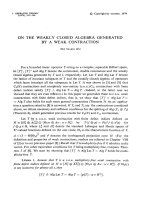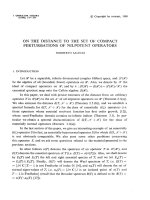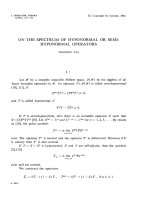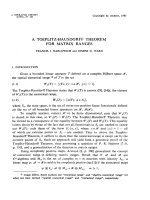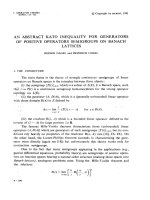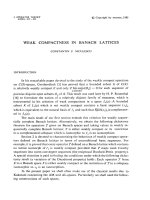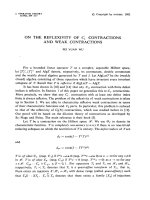Báo cáo toán học: "On the Parametric Affine Variational Inequality Approach to Linear Fractional Vector Optimization Problems" pot
Bạn đang xem bản rút gọn của tài liệu. Xem và tải ngay bản đầy đủ của tài liệu tại đây (163.57 KB, 13 trang )
Vietnam Journal of Mathematics 33:4 (2005) 477–489
On the Parametric Affine Variational
Inequality Approach to Linear Fractional
Vector Optimization Problems
T. N. Hoa, T. D. Phuong, and N. D. Yen
Institute of Mathematics, 18 Hoang Quoc Viet Road, 10307 Hanoi, Vietnam
Received March 07, 2005
Revised August 28, 2005
Abstract. Yen and Phuong (2000) have shown that the efficient solution set of a
linear fractional vector optimization problem can be regarded as the image of the
solution map of a specific parametric monotone affine variational inequality. This
paper establishes some facts about the domain, the image and the continuity of this
solution map (called the basic multifunction), provided that the linear fractional vector
optimization problem under consideration satisfies an additional assumption. The
results can lead to some upper estimates for the number of components in the solution
sets of linear fractional vector optimization problems.
1. Introduction
The problem of minimizing or maximizing several linear fractional objective
functions on a polyhedral convex set is called a linear fractional vector optimiza-
tion problem (LFVO problem for short). LFVO problems have a significant role
both in the management science and in the theory of vector optimization.
Linear fractional (ratio) criteria are frequently encountered in finance. The
reader is referred to [15, p. 337] for concrete examples of linear fractional criteria
in Corporate Planning and Bank Balance Sheet Management. Fractional objec-
tives also occur in other areas of management (for example, in transportation
management, education management, and medicine management).
In the theory of vector optimization, LFVO problems are important examples
of the so-called strictly quasiconvex vector minimization problems (or, the same,
strictly quasiconcave vector maximization problems) which have attracted much
478 T. N. Hoa, T. D. Phuong, and N. D. Yen
attention from researchers during the last two decades (see [1, 8, 16], and the
references therein). Meanwhile, the class of the LFVO problems encompasses
the class of the linear vector optimization problems.
Topological properties of the solution sets of LFVO problems were studied
in [1–3, 6, 8, 15, 17]. It is well known that the efficient solution set and the
weakly efficient solution set of a LFVO problem with a bounded feasible set are
connected [1, 3, 17]. Recently, it has been shown that the efficient solution set
and the weakly efficient solution sets of LFVO problems may be not contractible
even if they are path connected [7]. The example given by Choo and Atkins [3]
demonstrates that the efficient solution set and the weakly efficient solution set
of a LFVO problem may be disconnected if the feasible set is unbounded. In [6],
the authors have proved that for any integer m there exist LFVO problems with
m objective criteria whose efficient solution set and weakly efficient solution set
have exactly m components.
Algorithms for solving LFVO problems and/or the related post-optimization
problems have been proposed in [2, 12, 13].
Using the first-order necessary and sufficient optimality conditions for LFVO
problems, which were established by Malivert [12], Yen and Phuong [17] have
shown that the efficient solution set of any LFVO problem can be represented as
the image of the solution map of a specific parametric monotone affine variational
inequality. A similar representation is also valid for the weakly efficient solution
set. This parametric affine variational inequality approach to LFVO problems
has proved to be useful for studying topological properties of the solution sets
and solution stability of LFVO problems.
The aim of this paper is to develop furthermore the parametric affine varia-
tional inequality approach to LFVO problems given in [17]. Using the solution
existence theorem for affine variational inequalities due to Gowda and Pang [4],
we will obtain an upper estimate for the number of components in the domain of
the basic multifunction in the formulae for computing the solution sets of a cer-
tain type of LFVO problems. We will discuss the two conjectures related to the
upper continuity and the image of the basic multifunction, which were stated
in our preprint paper [5]. Further investigations in this direction can lead to
establishing tight upper estimates for the number of components in the solution
sets of LFVO problems.
The rest of the paper is organized as follows. Sec. 2 presents some prelim-
inaries. Sec. 3 gives an estimate for the number of components in the domain
of the basic multifunction. In Sec. 4 we construct a counterexample for the two
conjectures proposed in [5]. It demonstrates the striking facts that the basic
multifunction might not be upper semicontinuous on a component of its do-
main, and the image of a line segment though the basic multifunction might be
disconnected. Some concluding remarks and proposals for further investigations
are given in Sec. 5.
We now recall some standard notions and notation which will be used later
on. Let X, Y be some subsets of Euclidean spaces. A multifunction G : X → 2
Y
is upper semicontinuous (usc) at x ∈ X if for every open set V ⊂ Y satisfying
G(x) ⊂ V there exists a neighborhood U of x, such that G(x
) ⊂ V for all
Parametric Affine Variational Inequality to LFVO Problems 479
x
∈ U. If G is upper semicontinuous at every x ∈ X,thenitissaidthatG is an
upper semicontinuous multifunction. A subset Z of an Euclidean space is said
to be connected if one cannot find any pair (Z
1
,Z
2
) of disjoint nonempty open
subsets Z
1
,Z
2
of Z in the induced topology such that Z = Z
1
∪ Z
2
.Onesays
that Z is path connected if for any a, b ∈ Z there exists a continuous mapping
γ :[0, 1] → Z such that γ(0) = a, γ(1) = b. If for any given points a, b ∈ Z
there exists a sequence of line segments [z
i
,z
i+1
] ⊂ Z (i =0, ,k − 1) such
that z
0
= a and z
k
= b,thenZ is said to be connected by line segments.IfZ is
disconnected, then we denote by χ(Z) the (cardinal) number of components of Z.
By definition, a subset M ⊂ Z is said to be a component of Z if M is connected
and it is not a proper subset of any connected subset of Z. The cone generated
by Z and the convex hull of Z are denoted by cone Z and co Z, respectively. For
any w, w
∈ R
m
, the inequality w w
(resp., w<w
)meansw
i
w
i
(resp.,
w
i
<w
i
) for all i =1, ,m.IfM ⊂ R
n
is a convex set, then dim M denotes
the dimension of M, i.e., the dimension of the affine hull of M.IfM is a cone,
then we say that M is pointed if M ∩ (−M)={0}.
2. Preliminaries
Let f
i
: R
n
→ R (i =1, 2, ,m)bem linear fractional functions, that is
f
i
(x)=
a
T
i
x + α
i
b
T
i
x + β
i
for some a
i
∈ R
n
,b
i
∈ R
n
,α
i
∈ R, and β
i
∈ R.(Hereandinthesequel,
T
denotes the matrix transposition.) Let
Λ={λ ∈ R
m
+
:
m
i=1
λ
i
=1},
where R
m
+
= { λ =(x
1
, ,λ
m
) ∈ R
m
: λ
i
0 for all i}.Then
ri Λ = {λ ∈ R
m
+
:
m
i=1
λ
i
=1,λ
i
> 0 for all i}
is the relative interior of Λ.
Consider the linear fractional vector optimization problem
(P)
Minimize f (x)=(f
1
(x), ,f
m
(x)) subject to
x ∈ D := {x ∈ R
n
: Cx d},
where C is an (r × n)-matrix, d is an r-dimensional column vector. Throughout
this paper, it is assumed that b
T
i
x + β
i
=0foreveryi and for every x ∈ D.
Definition 2.1. Avectorx ∈ D is said to be an efficient solution of (P) if there
exists no y ∈ D such that f(y) f (x) and f(y) = f(x).Ifx ∈ D and there
does not exist y ∈ D such that f(y) <f(x),thenx is called a weakly efficient
solution of (P).
480 T. N. Hoa, T. D. Phuong, and N. D. Yen
The set of the efficient solutions (resp., the weakly efficient solutions) of (P)
is denoted by E(P) (resp., E
w
(P)).
Theorem 2.1 (see [12]). For any x ∈ D, the following assertions hold:
(i) x ∈ E(P) if and only if there exists λ =(λ
1
, ,λ
m
) ∈ ri Λ such that
m
i=1
λ
i
b
T
i
x + β
i
a
i
−
a
T
i
x + α
i
)b
i
,y− x
0 ∀y ∈ D, (2.1)
where ·, · denotes the scalar product in R
n
.
(ii) x ∈ E
w
(P) if and only if there exists λ =(λ
1
, ,λ
m
) ∈ Λ such that (2.1)
holds.
(iii) Condition (2.1) is satisfied if and only if there exists μ =(μ
1
, ,μ
r
), μ
j
0
for all j =1, ,r, such that
m
i=1
λ
i
b
T
i
x + β
i
a
i
−
a
T
i
x + α
i
)b
i
+
j∈I(x)
μ
j
C
T
j
=0, (2.2)
where C
j
denotes the j-th row of the matrix C and I(x)={j : C
j
x = d
j
}.
A detailed proof of Theorem 2.1 can be found also in [10].
The problem of finding x ∈ D satisfying (2.1) can be rewritten in the form
of a parametric affine variational inequality problem as follows
(VI)
λ
Find x ∈ D such that M (λ)x + q(λ),y− x 0 for all y ∈ D.
We put M(λ)=(M
kj
(λ)) ,
M
kj
(λ)=
m
i=1
λ
i
b
i,j
a
i,k
− a
i,j
b
i,k
, 1 k n, 1 j n,
and
q(λ)=
q
k
(λ)
,q
k
(λ)=
m
i=1
λ
i
(β
i
a
i,k
− α
i
b
i,k
), 1 k n,
where a
i,k
and b
i,k
are the k-th components of a
i
and b
i
, respectively.
As it has been noted in [17], since
M(λ)
T
= −M (λ), M (λ)v, v =0for
every v ∈ R
n
. Hence M (λ) is a positive semidefinite matrix. (Recall that an
(n × n)-matrix M is said to be positive semidefinite if Mv,v 0 for every
v ∈ R
n
.) Denote by F (λ) the solution set of (VI)
λ
. BytheMintylemma(see
[9]), F (λ) is a closed convex set (possibly empty). By Theorem 2.1 we have
E(P) =
λ∈ri Λ
F (λ)(2.3)
and
E
w
(P) =
λ∈Λ
F (λ). (2.4)
Parametric Affine Variational Inequality to LFVO Problems 481
Definition 2.2. The multifunction F :Λ→ 2
R
n
, λ → F(λ), is said to be the
basic multifunction associated to the problem (P).
Using (2.3), (2.4), and the following lemma, one can show that E(P) and
E
w
(P) are connected if D is bounded (see [17]).
Lemma 2.1 (see [16]). Suppose that X ⊂ R
k
is a connected set, and Y is a
subset of R
s
. If a multifunction G : X → 2
Y
is upper semicontinuous at every
x ∈ X and, for every x ∈ X,thesetG(x) is nonempty and connected, then the
set G(X):=
x∈X
G(x) is connected.
Choo and Atkins [3] showed that if D is bounded, then E
w
(P) is connected
by line segments. Up to now it is still not clear whether E(P) is also connected
by line segments if D is bounded. If D is unbounded, then E(P) and E
w
(P)
may be disconnected.
Example 2.1 (see [3]). Consider problem (P) with
D =
x =(x
1
,x
2
) ∈ R
2
: x
1
2, 0 x
2
4
,
f
1
(x)=−x
1
/(x
1
+ x
2
− 1),f
2
(x)=−x
1
/(x
1
− x
2
+3).
Then E(P) = E
w
(P) = {(x
1
, 0) : x
1
2}∪{(x
1
, 4) : x
1
2}.
It is of interest to know whether the estimates
χ(E(P)) m, χ(E
w
(P)) m (2.5)
hold true, or not. In our opinion, the parametric affine variational inequality
approach can help to study these estimates.
The following solution existence theorem for monotone affine variational in-
equality problems will be needed in the sequel.
Theorem 2.2. (see [4, p. 432] and [10, p. 103]). Let M be an (n × n)-matrix,
q ∈ R
n
a given vector, and D ⊂ R
n
a nonempty polyhedral convex set. Suppose
that M is positive semidefinite. Then the affine variational inequality problem
Find x ∈ D such that Mx+ q, y − x 0 for all y ∈ D
has a solution if and only if there exists x ∈ D such that
Mx+ q, v 0 ∀v ∈ 0
+
D,
where 0
+
D = {v ∈ R
n
: x +tv ∈ D for all x ∈ D and t ∈ R
+
} is the recession
cone of D.
Note that for the case D = {x ∈ R
n
: Cx d},wehave0
+
D = {v ∈ R
n
:
Cv 0} (see [14, p. 62]).
482 T. N. Hoa, T. D. Phuong, and N. D. Yen
3. Domain of the Basic Multifunction
In this section we establish some facts about the domain
domF := {λ ∈ Λ:F (λ) = ∅}
of the basic multifunction F :Λ→ 2
R
n
, which plays a key role in the formulae
(2.3) and (2.4). If F is usc on Λ, then combining these facts with Lemma 2.1 we
get some upper estimates for the number of components in the solution sets of
LFVO problems.
The main result of this section can be stated as follows.
Theorem 3.1. For problem (P), the following assertions are valid:
(i) If there exists
v ∈ R
n
\{0} such that 0
+
D =cone{v}, then domF is a
compact subset of Λ, χ(domF ) m. Moreover, each point in domF can be
joined with at least one vertex of Λ by a line segment which is contained in
domF .
(ii) If for each i ∈{1, ,m} either b
T
i
x +β
i
≡ 1 (i.e., f
i
is an affine function)
or a
T
i
x + α
i
≡ 1 (i.e., 1/f
i
is an affine function), then domF is a polyhedral
convex set.
The assumption stated in (i) is equivalent to saying that the cone 0
+
D =
{v ∈ R
n
: Cv 0} is pointed and dim 0
+
D = 1. There are many examples of
sets D satisfying this rather strict assumption. For the set D in Example 2.1,
we have 0
+
D =cone{¯v},wherev =(0, 1). If
D =
x ∈ R
2
: −1 x
2
− x
1
1
,
then 0
+
D =cone{¯v},wherev =(1, 1). If
D=
x ∈ R
3
:x
1
+x
2
–2x
3
1,x
1
–2x
2
+x
3
1, –2x
1
+x
2
+x
3
1,x
1
+x
2
+x
3
1
,
then 0
+
D =cone{¯v},wherev =(1, 1, 1).
For proving Theorem 3.1, we first establish two lemmas. Let Ω = Λ \ domF .
The next lemma shows that Ω is a convex set if the recession cone 0
+
D has a
simple structure.
Lemma 3.1. If there exists
v ∈ R
n
\{0} such that 0
+
D =cone{v}, then Ω is
a convex set, which is open in the induced topology of Λ.
Proof. Applying Theorem 2.2 to the problem (VI)
λ
,whereλ ∈ Λ, we deduce
that F (λ)=∅ if and only if
∀x ∈ D ∃v ∈ 0
+
D such that M(λ)x + q(λ),v < 0. (3.1)
Since 0
+
D =cone{v}, (3.1) is equivalent to the following property:
∀x ∈ D it holds M(λ)x + q(λ),
v < 0. (3.2)
Parametric Affine Variational Inequality to LFVO Problems 483
From the formulae of M (λ)andq(λ) given in the preceding section it follows
that
M(tλ
1
+(1− t)λ
2
)=tM(λ
1
)+(1− t)M(λ
2
)
and
q(tλ
1
+(1− t)λ
2
)=tq(λ
1
)+(1− t)q(λ
2
)
for all t ∈ [0, 1] and λ
1
,λ
2
∈ Λ. Combining this with the fact that λ ∈ Ωifand
only if (3.2) is valid, we conclude that Ω is a convex set.
We now show that Ω is open in the induced topology of Λ. As D is a
polyhedral convex set, by [14, Theorem 19.1] there exist k ∈ N and z
1
, ,z
k
∈
D such that
D =
x =
k
i=1
η
i
z
i
+ ρv : η
i
0fori =1, ,k,
k
i=1
η
i
=1,ρ 0
.
Then, from (3.2) and the property M(λ)
v,v = 0 it follows that
Ω=
λ ∈ Λ:M(λ)z
i
+ q(λ), v < 0 ∀i =1, ,k
.
This formula and the continuity of the functions
λ →M(λ)z
i
+ q(λ), v (i =1, ,k)
imply that Ω is an open subset of Λ in the induced topology.
In connection with Lemma 3.1, we would like to raise the following open
question:
Question 1. Without any additional assumption on the recession cone 0
+
D,is
it true that Ω is a convex set, which is open in the induced topology of Λ?
Lemma 3.2. If Ω ⊂ Λ is a convex set, then χ(Λ \ Ω) m. Moreover, each
point in Λ \ Ω can be joined with at least one of the vertices
e
i
=(0, , 1
i−th
, 0, ,0) (i =1, ,m)
of Λ by a line segment, which is contained in Λ \ Ω.
Proof. (This is a refined version of the proof given in [5]). It suffices to prove
that each point in Λ \ Ω can be joined with at least one of the vertices of Λ by a
line segment contained in Λ \ Ω, because the inequality χ(Λ \ Ω) m is a direct
consequence of this property.
Given any point λ ∈ Λ \ Ω, we consider the line segments
[λ, e
i
]={tλ +(1− t)e
i
: t ∈ [0, 1]} (i =1, ,m).
To obtain a contradiction, suppose that [λ, e
i
] ∩ Ω = ∅ for all i =1, ,m.
Then for each i we can find a point λ
i
∈ [λ, e
i
] ∩ Ω. Of course, λ
i
= λ. Hence
λ
i
= t
i
λ +(1− t
i
)e
i
for some t
i
∈ [0, 1). From this we deduce that
484 T. N. Hoa, T. D. Phuong, and N. D. Yen
e
i
=
1
1 − t
i
λ
i
−
t
i
1 − t
i
λ. (3.3)
As λ ∈ co{e
1
,e
2
, ,e
m
},thereexistμ
i
0,
m
i=1
μ
i
= 1, such that λ =
m
i=1
μ
i
e
i
.
Combining this with (3.3) we obtain
λ =
1+
m
i=1
μ
i
t
i
1 − t
i
−1
m
i=1
μ
i
1 − t
i
λ
i
. (3.4)
Since μ
i
/(1 − t
i
) 0 for all i and
m
i=1
μ
i
1 − t
i
=
m
i=1
μ
i
+
μ
i
t
i
1 − t
i
=1+
m
i=1
μ
i
t
i
1 − t
i
,
(3.4) shows that λ ∈ co{λ
1
,λ
2
, ,λ
m
}. By the convexity of Ω, from this we
conclude that λ ∈ Ω, a contradiction. The proof is complete.
It is likely that under the assumption of Lemma 3.2 the property “χ(ri Λ \
Ω) m and each component of ri Λ \ Ω is connected by line segments” is valid.
But we still do not have any proof for this fact.
Proof of Theorem 3.1. Since assertion (i) is immediate from Lemmas 3.1 and
3.2, we have to show only that (ii) is valid. If for each i ∈{1, ,m} either
b
T
i
x + β
i
≡ 1ora
T
i
x + α
i
≡ 1, then from the formulae
M(λ)=(M
kj
(λ)) ,M
kj
(λ)=
m
i=1
λ
i
(b
i,j
a
i,k
− a
i,j
b
i,k
)
for all 1 k n, 1 j n it follows that, for every λ ∈ Λ, M(λ) collapses to
the zero matrix. Hence, by Theorem 2.2, an element λ ∈ Λ belongs to domF if
and only if
q(λ),v 0 ∀v ∈ 0
+
D.
Since q(λ) is a linear function and 0
+
D is a polyhedral convex cone, this implies
that domF is a polyhedral convex set.
Theorem 3.1 shows that χ(dom F) 1 provided that every objective func-
tion is either an affine function or the reverse of an affine function. Note that
connectedness of the efficient set of a vector optimization problem with linear
objective functions and a polyhedral convex feasible set, which is called a linear
vector optimization problem, is a classical result (see [11]).
Example 3.1. Let us consider once again the problem given in Example 2.1 and
observe that the assumption of Lemma 3.1 is satisfied for this problem. Indeed,
since 0
+
D = {(α, 0) : α ∈ R
+
}, one can choose v =(1, 0). An elementary
investigation on the parametric affine variational inequality (VI)
λ
shows that
Ω=(
λ,
ˆ
λ):={tλ +(1− t)
ˆ
λ :0<t<1},
Parametric Affine Variational Inequality to LFVO Problems 485
where λ =
1
4
,
3
4
and
ˆ
λ =
3
4
,
1
4
. Therefore,
dom F =Λ\ Ω=co{(0, 1), (1, 0)}\Ω
=co{(0, 1),
λ}∪co {
ˆ
λ, (1, 0)}.
We see that dom F has two components.
In connection with the first assertion of Theorem 3.1, the following open
question seems to be interesting.
Question 2. Is it true that the conclusion of the first part of Theorem 3.1 is still
valid without the additional assumption on the recession cone 0
+
D?.
In order to derive information about the numbers χ(E
w
(P)) and χ(E(P))
from the information about the number χ(domF ), one has to investigate fur-
thermore the behavior of the basic multifunction. The following two conjectures
were stated in our preprint paper [5].
Conjecture 1. The basic multifunction F :Λ→ 2
R
n
is upper semicontinuous on
Λ.
Conjecture 2. If λ
1
,λ
2
∈ Λaresuchthat[λ
1
,λ
2
] ⊂ domF , then the set
F ([λ
1
,λ
2
]) is connected by line segments.
Note that both the conjectures are valid for the problem considered in Ex-
ample 3.1. If Conjecture 1 is true, then from Theorem 3.1 and Lemma 2.1
it follows that “If there exists
v ∈ R
n
\{0} such that 0
+
D =cone{v},then
χ(E
w
(P )) m”. If Conjecture 2 is true, by Theorem 3.1 one can assert that
“If 0
+
D =cone{v} for some v ∈ R
n
\{0},thenχ(E
w
(P )) m. Moreover, each
component of E
w
(P ) is connected by line segments”.
Unfortunately, the counterexample given in the next section shows that both
the conjectures are not true. We believe that the counterexample not only solves
the conjectures, but it is also very useful for understanding the behavior of the
basic multifunction.
4. Image of a Line Segment through the Basic Multifunction
To analyze the behavior of the basic multifunction λ → F (λ), we consider prob-
lem (P) with the following data:
D =
x ∈ R
2
: x
1
0,x
2
0,x
1
+ x
2
1
,
f
1
(x)=
x
1
+1
2x
1
+ x
2
,f
2
(x)=
−x
1
− 2
x
1
+ x
2
.
Then, in the notation of Sec. 2, we have
C =
⎛
⎝
−10
0 −1
−1 −1
⎞
⎠
,d=
⎛
⎝
0
0
−1
⎞
⎠
.
486 T. N. Hoa, T. D. Phuong, and N. D. Yen
Claim 1. The following formula is valid:
F (λ)=
⎧
⎪
⎪
⎪
⎪
⎪
⎪
⎪
⎪
⎪
⎪
⎪
⎪
⎪
⎪
⎨
⎪
⎪
⎪
⎪
⎪
⎪
⎪
⎪
⎪
⎪
⎪
⎪
⎪
⎪
⎩
{0}×[2, +∞)ifλ =
2
3
,
1
3
2 − 3λ
1
2λ
1
− 1
, 2
if λ =(λ
1
, 1 − λ
1
),
1
2
<λ
1
<
2
3
[1, +∞) ×{0} if λ =
1
2
,
1
2
{(1, 0)} if λ =(λ
1
, 1 − λ
1
), 0 λ
1
<
1
2
∅ if λ =(λ
1
, 1 − λ
1
),
2
3
<λ
1
1.
(4.1)
Proof. Let x ∈ D. By Theorem 2.1, x ∈ E
w
(P) if and only if there exist λ
1
0,
λ
2
0, λ
1
+ λ
2
=1,μ
1
0,μ
2
0,μ
3
0, such that
λ
1
(2x
1
+ x
2
)
1
0
− (x
1
+1)
2
1
+ λ
2
(x
1
+ x
2
)
−1
0
− (−x
1
− 2)
1
1
+
j∈I(x)
μ
j
C
T
j
=0
or, equivalently,
(λ
1
− λ
2
)(x
2
− 2)
−λ
1
(x
1
+1)+λ
2
(x
1
+2)
+
j∈I(x)
μ
j
C
T
j
=0. (4.2)
Case 1. I(x)=∅.Thenwehavex
1
> 0, x
2
> 0, x
1
+ x
2
> 1. In this case, (4.2)
is equivalent to the system of two conditions: x
2
=2,λ
2
= λ
1
[1 − 1/(x
1
+2)].
Taking into account the equality λ
1
+ λ
2
=1,weobtainλ
1
=(x
1
+2)/(2x
1
+3),
λ
2
=1− λ
1
.Sincex
1
∈ (0, +∞), it holds
1
2
<λ
1
<
2
3
. We can express
x =(x
1
,x
2
)viaλ =(λ
1
,λ
2
) as follows
x
1
=
2 − 3λ
1
2λ
1
− 1
,x
2
=2.
Case 2. I(x)={1}. Inthiscasewehavex
1
=0,x
2
> 1. The equation (4.2)
can be rewritten as the following
(λ
1
− λ
2
)(x
2
− 2)
−λ
1
+2λ
2
+ μ
1
−1
0
=0.
Combining this with the equality λ
1
+ λ
2
=1,weobtainx
2
2, λ
1
=2/3,
λ
2
=1/3, μ
1
=
1
3
λ
1
(x
2
− 2).
Case 3. I(x)={2}. Inthiscasewehavex
2
=0,x
1
> 1. We rewrite (4.2)
equivalently as follows
2(λ
2
− λ
1
)
−λ
1
(x
1
+1)+λ
2
(x
1
+2)
+ μ
2
0
−1
=0.
Parametric Affine Variational Inequality to LFVO Problems 487
As λ
1
+ λ
2
= 1, this implies λ
1
= λ
2
=1/2, μ
2
=1/2.
Case 4. I(x)={3}. Inthiscasewehavex
1
> 0,x
2
> 0,x
1
+ x
2
=1. The
equation (4.2) now becomes
(λ
2
− λ
1
)(x
1
+1)
−λ
1
(x
1
+1)+λ
2
(x
1
+2)
+ μ
3
−1
−1
=0.
This implies
μ
3
=(λ
2
− λ
1
)(x
1
+1),μ
3
=(λ
2
− λ
1
)(x
1
+1)+λ
2
.
It is clear that one cannot find multipliers λ
1
0, λ
2
0, λ
1
+ λ
2
=1,and
μ
3
0, which satisfy these two conditions.
Case 5. I(x)={1, 3}.Sincex
1
=0andx
2
= 1, we can rewrite (4.2) as follows
λ
2
− λ
1
2λ
2
− λ
1
+ μ
1
−1
0
+ μ
3
−1
−1
=0.
It is easily seen that there exist no multipliers λ
1
0, λ
2
0, λ
1
+ λ
2
=1,
μ
1
0andμ
3
0, which satisfy this equation.
Case 6. I(x)={2, 3}.Sincex
1
=1andx
2
= 0, (4.2) becomes
2(λ
2
− λ
1
)
3λ
2
− 2λ
1
+ μ
2
0
−1
+ μ
3
−1
−1
=0,
which yields
μ
2
= λ
2
,μ
3
=2(λ
2
− λ
1
),λ
2
λ
1
.
As λ
2
+ λ
1
= 1, we deduce that 0 λ
1
1/2, λ
2
=1− λ
1
.(Thecases
I(x)={1, 2} and I(x)={1, 2, 3} are excluded, because we assume that x ∈ D).
Summarizing the above results, we obtain (4.1).
Claim 2. The basic multifunction F is not upper semicontinuous on the line
segment
L := co
2
3
,
1
3
, (0, 1)
, (4.3)
which coincides with the set dom F .
Proof. Formula (4.1) shows that F is not upper semicontinuous at the point
(1/2, 1/2) ∈ L.
Claim 3. TheimageofthelinesegmentL through F is disconnected.
Proof. By (4.1) we have
F (L)=
[1, +∞) ×{0}
∪
[0, +∞) ×{2}
∪
{0}×[2, +∞)
.
So F (L) has two components.
The above example shows that the properties of the basic multifunction
stated in Conjecture 1 and Conjecture 2 (see Section 3), are not available for
488 T. N. Hoa, T. D. Phuong, and N. D. Yen
general LFVO problems. However, if we decompose the set L =domF into the
union of the two disjoint subsets
L
1
:=
t(0, 1) + (1 − t)
1
2
,
1
2
:0 t 1
,
L
2
:=
t
1
2
,
1
2
+(1− t)
2
3
,
1
3
:0 t<1
then, by virtue of (4.1), the following assertions hold true:
(i) Each subset L
i
(i =1, 2) is connected by line segments.
(ii) The restriction of F on each subset L
i
(i =1, 2) is an upper semicontinuous
multifunction.
(iii) The image of each subset L
i
(i =1, 2) through F is connected by line
segments.
Concerning the basic function F figured in (2.3) and (2.4), we say that
λ ∈ dom F is a regular point if F (λ) is bounded. If F (λ) is unbounded, we
say that λ is an irregular point. In order to make the above decomposition
L = L
1
∪ L
2
,wehaveusedtheirregularpoints
λ
1
:=
1
2
,
1
2
,λ
2
:=
2
3
,
1
3
.
Observe that the sets F (L
1
)andF (L
2
) are just the two components of the
weakly efficient solution set E
w
(P). Here we have m =2andE(P) = E
w
(P),
so the estimates in (2.5) are valid for the problem considered in this section.
5. Concluding Remarks
In this paper we investigate furthermore the parametric affine variational in-
equality approach to linear fractional vector optimization problems, which can
help to obtain tight upper estimates for the number of components in the so-
lution sets of these problems. Some results on the domain, the image, and the
continuity of the basic multifunction have been obtained.
Although the two conjectures stated in [5] are not true, the following claims
mightbevalid:1)ThesetdomF can be decomposed into the union of not more
than m subsets, each of them is connected by line segments; 2) The restriction
of F on each of the subsets is an upper semicontinuous multifunction; 3) The
image of each of the subsets through F is connected by line segments.
Thus, further efforts are needed to prove (or disprove) the estimates in (2.5).
New results, even for the case m = 2, would be of interest.
Acknowledgement. Financial support from the Vietnam National Program in Basic
Sciences is gratefully acknowledged. The authors thank Dr. Nguyen Quang Huy for
proposing a proof for Lemma 3.2 in this paper, and the anonymous referee for several
valuable remarks.
Parametric Affine Variational Inequality to LFVO Problems 489
References
1. J. Benoist, Connectedness of the efficient set for strictly quasiconcave sets, J.
Optim. Theory Appl. 96 (1998) 627–654.
2. E. U. Choo and D. R. Atkins, Bicriteria linear fractional programming, J. Optim.
Theory Appl. 36 (1982) 203–220.
3. E. U. Choo and D. R. Atkins, Connectedness in multiple linear fractional pro-
gramming, Management Science 29 (1983) 250–255.
4. M. S. Gowda and J. -S. Pang, On the boundedness and stability of solutions to
the affine variational inequality problem, SIAM J. Control Optim. 32 (1994)
421–441.
5. T. N. Hoa, T. D. Phuong, and N. D. Yen, Number of Connected Components of
the Solution Sets in Linear Fractional Vector Optimization, Preprint, 2002/41,
Institute of Mathematics, Hanoi.
6. T. N. Hoa, T. D. Phuong, and N. D. Yen, Linear Fractional Vector Optimization
Problems with many Components in the Solution Sets, Preprint 2004/05, Institute
of Mathematics, Hanoi; J. Industrial and Management Optim.(to appear).
7. N. Q. Huy and N. D. Yen, Remarks on a conjecture of J. Benoist, Nonlinear
Analysis Forum 9 (2004) 109–117.
8. N. Q. Huy and N. D. Yen, Contractibility of the solution sets in strictly quasicon-
cave vector maximization on noncompact domains, J. Optim. Theory Appl. 24
(2005) 615–635.
9. D. Kinderlehrer and G. Stampacchia, An Introduction to Variational Inequalities
and Their Applications, Academic Press, New York, 1980.
10. G. M. Lee, N. N. Tam, and N. D. Yen, Quadratic Programming and Affine Varia-
tional Inequalities: A Qualitative Study, Series: Nonconvex Optimization and Its
Applications, Vol. 78, Springer–Verlag, 2005.
11. D. T. Luc, Theory of Vector Optimization, Springer–Verlag, Berlin, 1989.
12. C. Malivert, Multicriteria fractional programming, Proceedings of the Catalan
Days on Applied Mathematics, Presses of Universitaires de Perpinan, 1995, pp.
189–198.
13. C. Malivert and N. Popovici, Bicriteria linear fractional optimization,In: Opti-
mization, Lecture Notes in Economic and Mathematical Systems, 481, Springer,
Berlin, 2000, pp. 305–319.
14. R. T. Rockafellar, Convex Analysis, Princeton University Press, Princeton, New
Jersey, 1970.
15. R. E. Steuer, Multiple Criteria Optimization: Theory, Computation and Applica-
tion, John Wiley & Sons, New York, 1986.
16. A. R. Warburton, Quasiconcave vector maximization: Connectedness of the set
of Pareto-optimal and weak Pareto-optimal alternatives, J. Optim. Theory Appl.
40 (1983) 537–557.
17. N. D. Yen and T. D. Phuong, Connectedness and Stability of the Solution Sets in
Linear Fractional Vector Optimization Problems, In: Vector Variational Inequal-
ities and Vector Equilibria, F. Giannessi (Ed.), Kluwer Academic Publishers,
2000, pp. 479–489.
